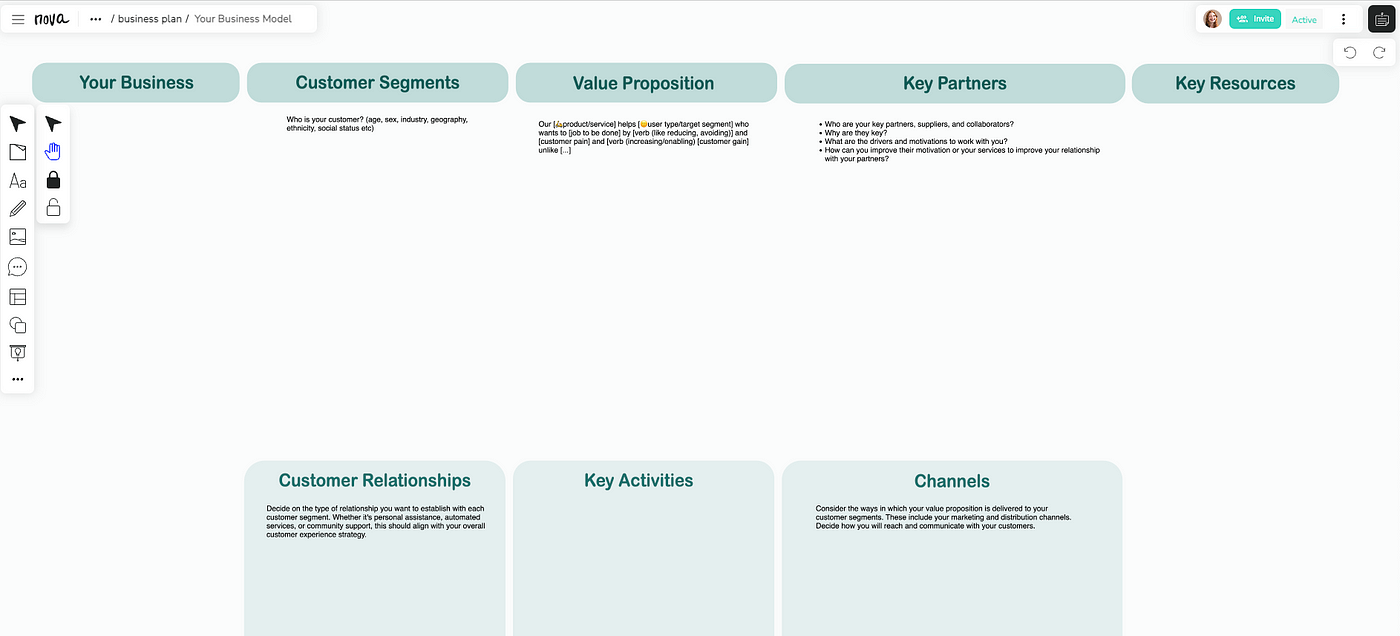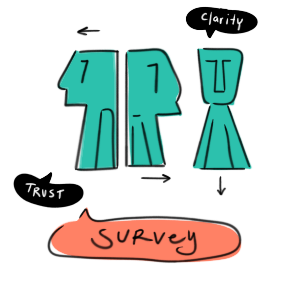Business Model Canvas: Explained
The Business Model Canvas is a strategic management tool used for developing new business models or documenting existing ones. It’s a visual chart with elements describing a firm’s value proposition, infrastructure, customers, and finances. Using it simplifies the process of brainstorming and aligning business activities. Here’s how to use it effectively in simple steps:

1. Gather Your Team: Begin by assembling a team involved in your business planning process. Collaborating ensures diverse perspectives and enhances the richness of your strategy.
2. Prepare Your Canvas: You can either use a large physical poster or an online tool designed for creating a Business Model Canvas. The canvas is divided into nine key segments.
3. Start with the Value Proposition: This is the core of your business model. Define what makes your product or service unique and why customers would choose you over competitors. Consider what problems you solve and the needs you meet.
To innovate and refine your business model, asking the right questions is crucial. These thought-provoking questions can help you explore new possibilities, uncover potential improvements, and ultimately create a more robust and innovative business model:
What problem are we solving?
- Is this a real problem for a significant number of potential customers?
- Are there other problems or related needs that are currently unaddressed?
What value do we deliver to the customer?
- What makes us unique from competitors in the eyes of our customers?
- Can we enhance our value proposition to deliver even more to our customers?
4. Define Customer Segments: Identify who your customers are. These are the people who will benefit from your value proposition. Think about the different groups of people or companies that your business aims to reach and serve.
Who are our most important customers?
- Have we overlooked any potential customer segments that might benefit from our product/service?
- What are the specific characteristics and behaviors of our ideal customer?
5. Map Out Channels: Consider the ways in which your value proposition is delivered to your customer segments. These include your marketing and distribution channels. Decide how you will reach and communicate with your customers.
Through which channels do our customer segments want to be reached?
- Are there new or unconventional channels that we haven’t considered yet?
- How can we optimize our channel strategy to improve customer experience?
6. Establish Customer Relationships: Decide on the type of relationship you want to establish with each customer segment. Whether it’s personal assistance, automated services, or community support, this should align with your overall customer experience strategy.
What type of relationship do each of our customer segments expect us to establish?
- Could changing our interaction model increase customer loyalty or sales?
- Are there new technologies or methods that could reshape our customer relationships?
7. Determine Key Activities: List the most important activities needed to make your business model work. This could include production, problem-solving, platform management, etc.
What key activities are necessary for our success?
- Are there any activities that we can streamline or eliminate without affecting performance?
- Could new technologies improve our efficiency or effectiveness?
8. Identify Key Resources: These are the assets required to create value for your customers, such as your team, capital, intellectual property, and your network.
What are our key resources?
- Are there underutilized resources that we can leverage more effectively?
- Could we form partnerships to access resources we lack?
9. Outline Key Partnerships: Think about other companies or individuals who help your business model function. Partners can help reduce risks or provide resources you don’t have internally.
Who are our key partners?
- How do our partnerships contribute to our value proposition?
- Are there potential partners we haven’t considered that could help us reach new markets or enhance our capabilities?
10. Detail Cost Structure: List all the major costs involved in operating your business model. Understanding where the money goes will help in making informed financial decisions.
What is our cost structure? — Which are our most costly resources and activities? Are they justified? — Can we reduce costs without compromising quality?
11. Clarify Revenue Streams: Describe how your business makes money. This might include sales, subscriptions, advertising, or other methods of generating income from your value proposition.
How do we measure success? — What metrics or indicators best reflect the health and progress of our business? — Are there new metrics we should consider to better understand our business dynamics?
Here is a quick video.
Considerations While Using the Canvas:
- Iterate: The Business Model Canvas is designed to be a dynamic tool. Update it as you validate ideas and learn from real-world experiences.
- Focus on Customer Needs: Always align elements of your canvas with what your customers value. This alignment is critical for creating a successful business model.
- Balance Detail and Simplicity: While detail is important, the power of the Business Model Canvas lies in its simplicity. Avoid over-complicating the canvas; keep it readable and easy to understand.
Why?
Using a Business Model Canvas can significantly clarify what your business does and how it does it, facilitating a strategic outlook and helping you communicate your business model more clearly.
What other questions could you ask?
How can we use technology to enhance our business model?
- Are we fully leveraging digital tools and platforms for efficiency and outreach?
- What emerging technologies could disrupt our industry or create new opportunities?
What are the biggest risks to our business?
- How can we mitigate these risks effectively?
- Are there risks we’ve not yet considered?
Where can you find this tool?
- Online websites and platforms.
- Nova — Free template and tips.
means to structure a business — it’s a way to ignite innovation and strategically plan for sustainable success. Whether you’re refining an existing business or starting a new venture from scratch, the Business Model Canvas offers a clear and concise framework for capturing the essence of your business model.
I encourage you not just to use this tool in solitude but to share it with your team and collaborate. The power of the Business Model Canvas is amplified when used collectively. The diverse insights and perspectives of a team can transform a good idea into a great one, ensuring all aspects of the business are thoroughly explored and optimized.
Moreover, for those of you mentoring or connected with budding entrepreneurs, this tool provides a foundational framework that can greatly simplify the daunting task of business planning. It helps visualize the components of a business and assess their interconnections, making it an invaluable roadmap for new entrants into the business world.
To make this tool as accessible as possible, I’m pleased to share that the Business Model Canvas is available for free at Nova. This is an excellent resource not only for individual entrepreneurs but also for educational purposes in workshops and classrooms.
So, whether you’re part of a startup, a seasoned enterprise, or in the business of educating others, I invite you to utilize this resource. Implement it, share it, and watch as the canvas guides you through the complexities of business planning. Let’s spread the word and help more businesses flourish by sharing this invaluable tool. After all, a well-planned business is more than just a profit generator; it’s a platform for innovation and change. Share the Business Model Canvas with your network, and let’s help everyone build stronger, more resilient businesses.

